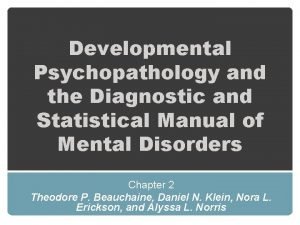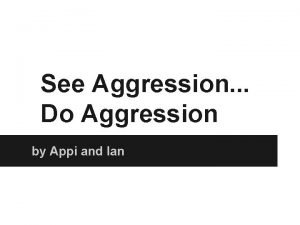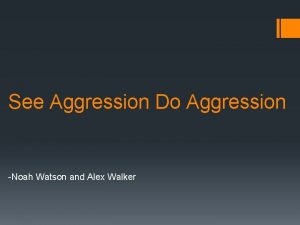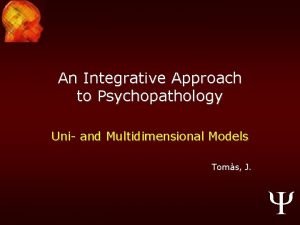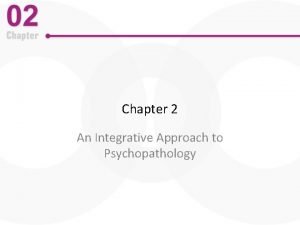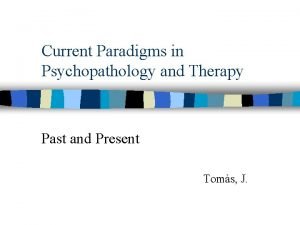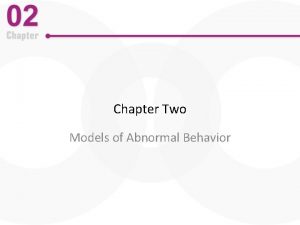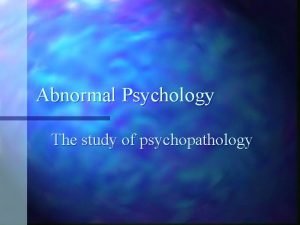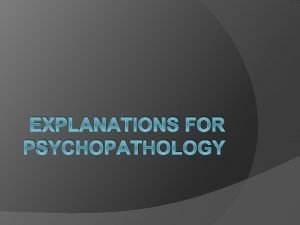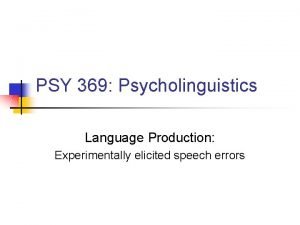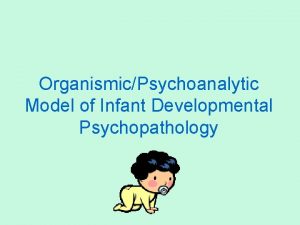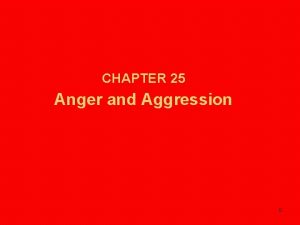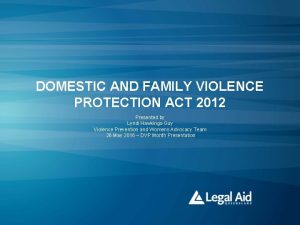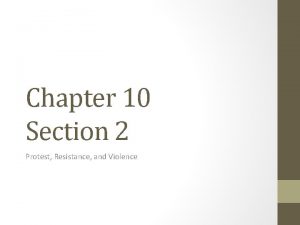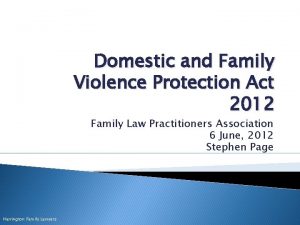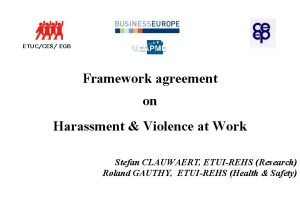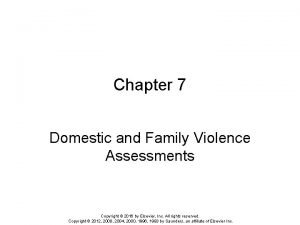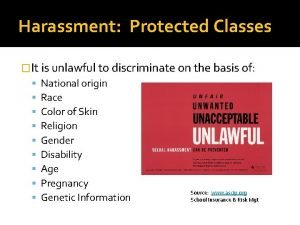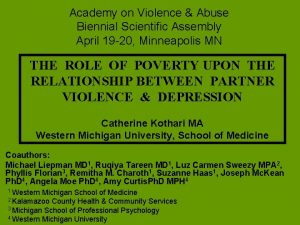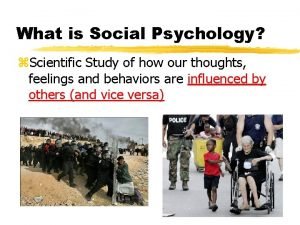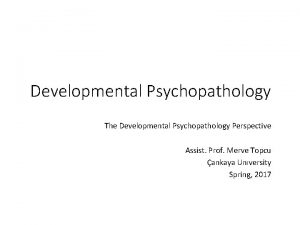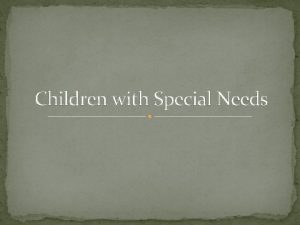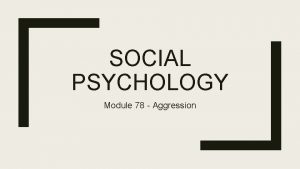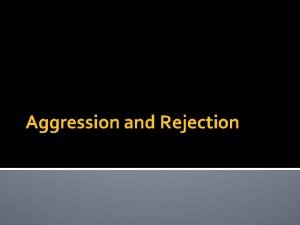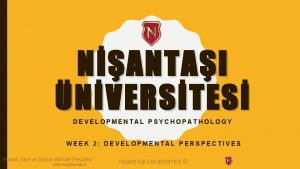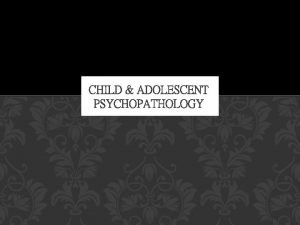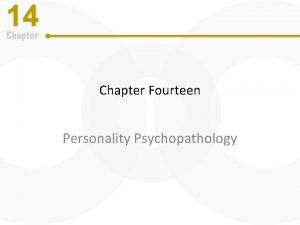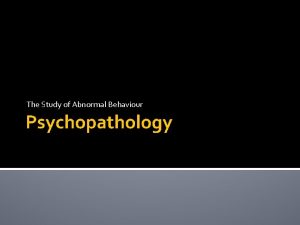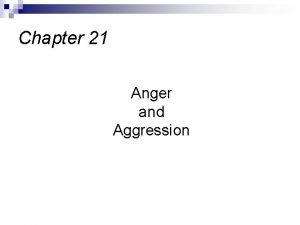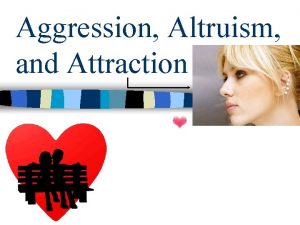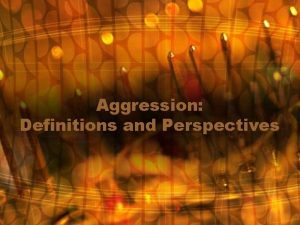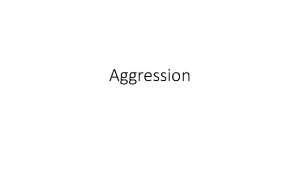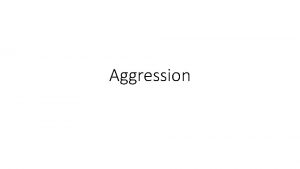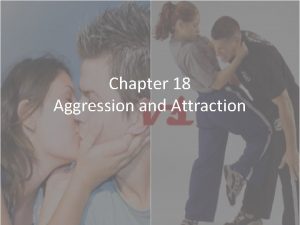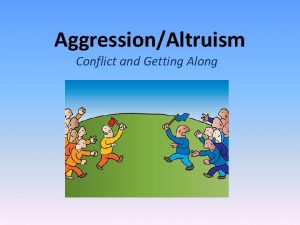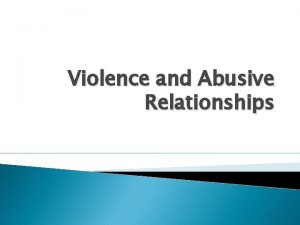Aggression Violence and Psychopathology A Developmental Approach Hans


































- Slides: 34

Aggression, Violence and Psychopathology: A Developmental Approach Hans Steiner, MD Professor, Division of Child Psychiatry Stanford University School of Medicine

Disclosure Information • Consultant for: Abbott Laboratories, Janssen Pharmaceutica • Receives research support from: Abbott Laboratories, Astra Zeneca, Janssen Pharmaceutica, Pfizer, Inc. , Wyeth-Ayerst, Solvay Pharmaceuticals, Glaxo. Smith. Kline • Speaker for: Abbott Laboratories, Janssen Pharmaceutica, Pfizer, Inc. , Astra. Zeneca

Disclaimer All current psychopharmacologic treatments for aggression and its disorders in children and adolescents are off-label.

The Current Lecture • The aggression system • Update on the psychopharmacology of juvenile aggression • Meta-analysis of stimulants and aggression • Relationship of aggression to psychiatric trauma and psychopathology • Reactive/Affective/Defensive/ (RAD) Aggression • Antikindling treatment of aggression based on this model • Early developmental manifestations of RAD aggression

The Aggression System Event Primary Appraisal: Perception, Defense Sensorium Affective Activation: Anger Limbic System Pragmatics: Assertion, Aggression, Violence Striatum Secondary Appraisal (EF) Prefrontal Lobes

Randomized, Placebo-Controlled Clinical Trials of Medication for the Treatment of CD • 13 studies, 559 subjects, 9 (8? ) positive for medications, 4 (5? ) equivocal • Agents studied: Li, DVPX, Risperidone, Haloperidol, Molindone, Methylphenidate (MPH), CBZ, Vitamins • Average Duration: 10 weeks, no long-term follow up, few comparative studies, small samples • BUT antipsychotics are most commonly prescribed (60 -80%) for aggression, regardless of diagnosis Steiner, January 2002

Psychopharmacology of Aggression Effects of Stimulants in ADHD: A Meta-analysis • 28 studies – Criteria: ADHD, peer reviewed, placebo-controlled, age <18, scaled aggression • 2 with MR and CD as primary diagnoses each; rest were ADHD; 75% comorbid with ODD, CD • Average N=24 – 88% boys age: 9. 7 (7. 7 -14. 4) – MPH in 75% (dose 24 mg/day); duration = 13 days Connor et al, 2002

Psychopharmacology of Aggression Effects of Stimulants in ADHD • Overt aggression – – Clinician (d =. 77) Parent (d =. 57) Teacher ratings (d =. 93) All significant • Presence of MR and CD/ODD reduces Effect Size • AMPH and MPH equally effective (. 8); PEM more (1. 6) Connor et al, 2002

Psychopharmacology of Aggression Effects of Stimulants in ADHD • Covert aggression – Clinician (d=. 81) significant – Parent (d=. 37) – Teacher ratings (d=. 54) not significant (but wide range, only seven studies) • Drug type did not make a difference, duration and dose weakly contributed • Overall sample age correlated positively with effect size; no gender effects Connor et al, 2002

Psychopharmacology of Aggression Effects of Stimulants in ADHD • Conclusion: Stimulants have significant effects on aggression (especially overt, especially when ADHD is primary diagnosis and not comorbid with CD, MR); and maybe in older subjects • Limitations – – Not all double blind Short duration No long term follow-up Other comorbidities? – PTSD, bipolar Connor et al, 2002

The Aggression System: Influences and Limits Environment (e. g. , substances, socialization, education) Psychiatric Trauma & related pathologies Aggression System Constitution (e. g. , genetics, perinatal injury) Development and Maturation (e. g. , diversification of affect, intentionality, cruelty)

Is there reason to think that trauma plays a role in disturbances of aggression? • Developmental epidemiological studies (Widom, 1989) • Community violence exposure studies (Osofsky, 1995; Schwab-Stone, 1999) • Clinical self report studies (Burton et al, 1994) • Structured interview studies (Steiner et al 1997; Cauffman et al 1998; Steiner et al 2002) • Transcultural studies (Aichhorn, 1935; Rushkin et al, 2002)

PTSD in Delinquents: What events do boys and girls report? PDI-R Results % of Subjects 2 =43. 0 DF= 4, p= 0. 001 Types of Trauma Steiner et al, 1997

PTSD in Female Incarcerated Delinquents: 1997 % X 2=10. 7 p<0. 005 Cauffman et al, 1998

PTSD in California Youth Authority Study REM-71 Factors: Primary Appraisal - Defenses Standard Scores All p’s <0. 05 Steiner et al, 1997 Cauffman et al, 1998

PTSD in CYA Study WAI Factors: Activation and Secondary Appraisal Standard Scores All p’s <0. 05 Steiner et al, 1997 Cauffman et al, 1998

Structured Interviews in Incarcerated Youth: Externalizing and Internalizing Disorders Females (n=140) • Externalizing Disorders - 96% Males (n=650) • Externalizing Disorders - 97% – Disruptive Disorders 94% – Substance Use 85% • Internalizing Disorders - 64% – Depression – Anxiety 24% 55% – Disruptive Disorders – Substance Use 95% 85% • Internalizing Disorders - 29% – Depression – Anxiety 8% 26% Steiner et al, 2002 – new data (unpublished)

Components of the Aggression System Which Should Be Affected by Trauma • Primary Appraisal: Defenses – YES – Feldman, Araujo & Steiner, 1996; Steiner, Garcia and Matthews, 1997 • Affective Activation: Anxiety and Aggression often go together – YES- Steiner, Garcia and Matthews, 1997; Cauffman et al, 1998; NEW DATA • Secondary Appraisal: Restraint, Impulse control is impaired as a function of trauma– YES This profile leads to reactive/affective/defensive (RAD) aggression Steiner et al, 2002 – new data (unpublished)

Clinical Subtypes of Aggression: Form and Causal Process Aggression Act Overt Premed. Process Oppositional Covert Reactive, Affective, Defensive itated Escalating Situational Explosive Psychopathological Steiner et al, 2002 – new data (unpublished)

How do we get from psychiatric trauma to reactive/affective/defensive aggression? • Eysenk’s antisocialization hypothesis: high levels of anxiety in high criminogenic environments predict future maladaptive aggression in adolescents • Le. Doux’s anxiety/active coping hypothesis: trauma induced anxiety can be controlled by active coping (in this case of criminogenic environments involving aggression) • Post’s PTSD kindling hypothesis: Repeated traumatization leads to increasingly facile affective activation which becomes a mixture of anxiety, depression, anger

Divalproex Sodium in CD: Design Weeks 0 -7 0 1 2 3 4 5 6 7 Measures Best est. dx (open) CGI (O) WAI (Blind) DSS/RST REM (B) F 1/F 2 YSR (B) Int/Ext HD/LDCD (B) CGI (B) High dose = 1000 mg/d Low Dose 250 mg/d X X X X W O S E T H X X X X Steiner, 2002

Divalproex Sodium for the Treatment of Severe CD in Boys • Low ( 125 mg) and high dose (1000 mg) 7 -week DBPC clinical trial • Sample: 70 boys consented, 61 completed 3 month protocol (7 weeks on medication); 58 had all outcome measures • Multi-method, Multi-trait measures • CGI-I Intent-to-treat: 35% responded (53% in high dose vs. 8% in low dose condition) • Significant differences in self rated slopes of weekly restraint • No significant side effects (drowsiness, GI upset), easily tolerated Steiner, 2002

Different Patterns of Aggression Respond to Divalproex Sodium • 61 adolescent males into predominantly High Distress (HDCD) and Low Distress (LDCD) Conduct Disorders • Low distress CD show predominantly premeditated aggression; High Distress CD are predominantly RAD aggressive. • In a 7 week RDBPC trial of DVPX we found that the HDCD had a more robust response to therapeutic doses of DVPX Sodium • Responsive targets were: observer rated CGI, weekly slopes of self reported Distress (decreased) and Restraint (increased) New Poster APA, 2002

HDCD and LDCD in Double-Blind, Placebo-Controlled Divalproex Trial Weekly Slopes of Restraint Standard Scores Weekly Slopes of Distress Low Dose High Dose 2 x 2 ANOVA; HD/LDCD effect p=. 049 Low Dose High Dose 2 x 2 ANOVA; NS Remsing L, Chang K, Saxena K, Silverman M, Steiner H. Divalproex Sodium in Conduct Disorder: Response Rates and Aggression. , Scientific Proceedings Of The Annual Meeting Of The APA, May 2002

Predictors of Response to DVPX in CD Likelihood ratio Chi Square (DF 5)= 20. 51, p=0. 001 Restraint Factor 2 (Mature) Defenses Distress Good Response Factor 1 (Immature) Defenses (OR= 3. 1, p=0, 046), Acting Out! Divalproex Sodium at 1000 -1500 mg q d (OR=16. 3, p=0. 002) Week 0 Week 8 Silverman M, Remsing L, Saxena K, Chang K, Steiner H. Trait and State predictors of Response to Divalproex Sodium in Conduct Disorders. Annual meeting of the American Academy of Child and Adolescent Psychiatry, San Francisco, October 2002

Divalproex in PTSD: The Sample • 12 boys • Ages 14 -17, mean 15. 9 (SD=0. 9) • Highly comorbid: – Conduct disorder (12) – Mood Disorder (8) – ADHD (6) • Average number of diagnoses: 4. 8 (SD=1. 2) Silverman M, Carrion V, Chang K, Matthews Z, Peterson M, Steiner H : Divalproex Sodium and PTSD Treatment: A Randomized Controlled Clinical Trial, Scientific Proceedings Of The Annual Meeting Of The American Academy Of Child And Adolescent Psychiatry, 17: 115, 2001

Divalproex Study in PTSD: Outcome by Blind Global Clinician Ratings (Intent to Treat Analyses) Total N=12 RS 1 -5 p= 0. 045 0. 03. 1 0. 02 Observer Ratings Silverman M et al, Scientific Proceedings Of The Annual Meeting Of The American Academy Of Child And Adolescent Psychiatry, 17: 115, 2001

Divalproex Study in PTSD (Intent to Treat Analyses) Weekly Slopes of Distress Weekly Slopes of Restraint Total N=12 R/S p= . 2 . 3 . 08 . 5 . 4 p= 0. 025 0. 02 . 3 . 03 . 6 WAI Subscales Silverman M et al, Scientific Proceedings Of The Annual Meeting Of The American Academy Of Child And Adolescent Psychiatry, 17: 115, 2001

Implications of DBPC trials in CD 2002 Emerging Pathways • Lithium may be most applicable in prepubertal aggression with a reactive/affective/defensive profile • Divalproex may be most useful in pubertal CD with a high affective component either to mood disorder or trauma – especially chronic trauma • Antipsychotics (risperidone; haloperidol; may be most helpful when executive cognitive functions are impaired (MR, PDD, psychosis) • Stimulants should be considered when there is a comorbid attention deficit (caveat – juvenile bipolar)

The Developmental Model for Disruptive Behavior Disorders Risk Factors Time Protective Factors Peer Relationship Factors Performance Factors Personality Factors Parenting Factors Constitutional Factors Ecological Factors Health CD, ODD

Observing Infants’ Aggression at 1 Year: Teen Mothers’ and Researchers’ Reports • Sample of 60 teen mothers at high risk , predominantly Hispanic, 33 boys and 28 girls followed from pre-birth, assessment at 13 months • Variables: maternal psychopathology, CAPI, PSI; Reported infant aggression, negative emotional reactivity and emotion regulation; Same infant variables observed • Experimental tasks: strange situation, Bailey testing Gschwendt, Zelenko & Steiner, 2002

Observing Infants’ Aggression at 1 year: Results • In infants, negative affective reactivity, emotion regulation and aggression were significantly correlated by mother’s and observer’s reports, separately (Spearman’s 0. 47 to -. 81, p’s < 0. 05) • Maternal depression, anxiety, CAPI and PSI correlated with mother’s reports of infant aggression, negative affective reactivity (Spearman’s 0. 22 to 0. 47, p’s <0. 05) in infants • Mother’s reports correlated with observer ratings only if their own functioning was taken into account Gschwendt, Zelenko & Steiner, 2002

Early Developmental Manifestations of Reactive/affective/defensive Aggression Anxiety, Depression, Parenting Stress, Abuse Potential Parent Child Negative affective reactivity, poor emotion regulation, aggression 2002

Trauma and Reactive/Affective/Defensive (RAD) Aggression – Summary APA 2002 • Traumatic Events are extremely common in the lives of maladaptively aggressive (MAA) youth • PTSD is extremely common in MAA youth • PTSD leads to faulty primary appraisal, anxious/angry activation and loss of self restraint – reactive/affective/defensive aggression – kindling • Treatment with DVPX is effective in CD, even more effective in CD and PTSD • Antikindling treatment seems to treat reactive/affective/defensive aggression; good response is predicted by variables related to PTSD at baseline • Early antecedents of reactive/affective/defensive aggression involve negative affect/ poor emotion regulation and aggression in the infant (by both observer and mothers’ reports and increased attribution of negative characteristics by the mother as a function of her anxiety and depression
 Developmental psychopathology approach
Developmental psychopathology approach Chapter 27 anger aggression and violence
Chapter 27 anger aggression and violence See aggression do aggression
See aggression do aggression See aggression do aggression
See aggression do aggression Integrative approach to psychopathology
Integrative approach to psychopathology Integrative approach to psychopathology
Integrative approach to psychopathology Biological paradigm of psychopathology
Biological paradigm of psychopathology One dimensional model psychology
One dimensional model psychology What is psychopathology
What is psychopathology The supernatural tradition
The supernatural tradition Psychopathology freud
Psychopathology freud Psychopathology
Psychopathology Packet switching datagram and virtual circuit approach
Packet switching datagram and virtual circuit approach Tony wagner's seven survival skills
Tony wagner's seven survival skills Chapter 25 anger and aggression
Chapter 25 anger and aggression Human acts and acts of man
Human acts and acts of man Domestic and family violence protection act 2012
Domestic and family violence protection act 2012 Gandhi king and mandela what made non-violence work dbq
Gandhi king and mandela what made non-violence work dbq Chapter 9 lesson 2 resolving conflicts
Chapter 9 lesson 2 resolving conflicts Chapter 10 section 2 protest resistance and violence
Chapter 10 section 2 protest resistance and violence S68r family law act
S68r family law act Chapter 9 resolving conflicts and preventing violence
Chapter 9 resolving conflicts and preventing violence Ebb tide tackle
Ebb tide tackle Framework agreement on harassment and violence at work
Framework agreement on harassment and violence at work Routine, universal screening for domestic violence means: *
Routine, universal screening for domestic violence means: * Workplace violence and harassment quiz answers
Workplace violence and harassment quiz answers Seceding states of the confederacy
Seceding states of the confederacy Academy on violence and abuse
Academy on violence and abuse Theoretical models of counseling
Theoretical models of counseling Waterfall approach marketing example
Waterfall approach marketing example Multiple approach avoidance
Multiple approach avoidance Bandura's reciprocal determinism
Bandura's reciprocal determinism What is research approach
What is research approach Traditional approach in system analysis and design
Traditional approach in system analysis and design Self fulfilling prophecy psychology
Self fulfilling prophecy psychology
